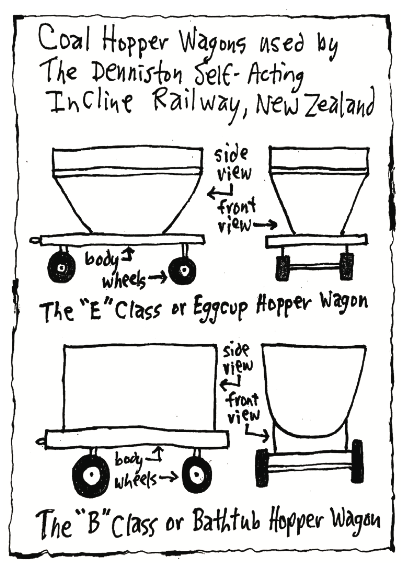Table of Contents
You can purchase Nieuw Zeeland An English-Speaking Polynesian Country With A Dutch Name: A Humorous History of New Zealand by Geoffrey Corfield from Amazon today.

The Southland Provincial Council (Invercargill), wants to build railways north from Invercargill to Winton, and south from Invercargill to Bluff, to service the gold rush at Queenstown and Arrowtown. It is convinced by an Australian entrepreneur to build the Invercargill-Winton section as a wooden railway. Wooden rails, not iron ones. Square wooden rails that can be turned over and used on all four sides. Wooden rails that will cost only one-quarter the price of iron rails. Wooden rails that will provide a better grip for the specially-made rolling stock which will use a guide wheel to keep the cars on the track.
It all sounds too good to be true for a provincial government well and truly hypnotized by gold fever and the power of government (the Victoria, Australia colonial government had gold fever too, but they turned down this wooden railway idea). A test track is built and everything goes well. The wooden railway is given the government go ahead.
The first 15km of track from Invercargill to Makarewa is completed in October 1864, and the first excursion train sets off. And then it rains. The tracks are so slippery the engine’s wheels spin and spin. The train doesn’t return until midnight, and by then many people had abandoned it to walk back, or got out and camped for the night.
And there are more problems too. The wooden rails wear down, warp and rot; maintenance costs exceed income; and the service is so slow (even when it doesn’t rain), that it’s faster to walk. Eventually a railway of iron rails is completed to Winton (1870), but by that time the gold rush is over and the provincial government of Southland is bankrupt (the railway is extended to Kingston in 1877).
The Denniston Self-Acting Incline Railway (1879-1967)
Another South Island railway. But this one is not only successful and probably the most interesting railway ever built in New Zealand; but one of the most interesting railways ever built in the world too.
In 1879 R.B. Denniston of The Westport Colliery Company of Westport, South Island, develops an ingenious gravity-propelled railway system to transport coal from the mining town of Denniston, on top of a steep ridge east of Westport, to Waimangaroa 9km west on the coast.
The engineering challenge is to overcome an incline falling off the ridge 518 metres in 1.67 km, with some gradients at 1/1.3. The solution is The Denniston Self-Acting Incline Railway. No motorized engines required. The loaded coal hopper wagons at the top are locked onto a 4” thick wire rope and go down the 3’6” gauge track by gravity. The weight of the loaded wagons going down (the “Company side”), pulls the empty wagons back up (the “Donkey side”). Simple but effective. And it works (it wasn’t a government project).

The BFD. Illustration by Inkblot
The railway is split into two sections. After the first short, steep section the wagons are disconnected and reconnected up to a longer, gentler section that takes them down to an assembly point where the hopper wagons are detached from the hopper bodies and put on trains to the coast. Here they are lifted over the holds of ships by cranes, the bottom doors of the wagons are manually opened, and the coal is loaded into ships. The wagons then go back up to the top to be reloaded.
Braking was by means of a water braking system involving direct-acting horizontal winding drums with hydraulic pistons to slow the rotation of the drums; and by a strap brake system around a rope drum, with the descending rope on one side of the drum and the ascending rope on the other. The system even had an indicator board where the location and progress of each wagon could be monitored by an operator.
The wagons going down reached speeds of 70km/hr. Before there was a road up the ridge, everything going up to the town of Denniston (pop. 2,000) at the top, went up in the empty wagons. Including some of the people. Who of course went down in the wagons too. There were accidents. After a wagon jumped the tracks and killed four people in 1884, they built a path up the ridge, later a road. (They also transported dead bodies down in the empty wagons for burial elsewhere as the ground at Denniston was too hard to dig for graves.)
The railway closed on 16 August 1967, when coal was transported solely by road, and the coal town of Denniston became a ghost town as the people moved away to the coast (better weather). The coal mine closed in 1995. Denniston is now an historic site owned by The New Zealand Department of Conservation. There is a Denniston Heritage Charitable Trust and a “Friends of the Hill Society”.
“ Damn Denniston,
Damn the track,
Damn the way both there and back.
Damn the wind and damn the weather, God damn Denniston altogether.”
(but the railway was still quite something)
__________________________
Unfortunately, the New Zealand government system did not function as efficiently as The Denniston Incline Railway, and finally, in 1876, the national government becomes so totally fed up with the provinces that it abolishes them once and for all. Gone. They are replaced by 63 local county councils with a set list of responsibilities, which together with the existing borough councils in the larger towns and cities, forms New Zealand’s local government system.
New Zealand then has only two levels of government: national and local. It’s all it’s ever needed. It still has only two levels of government. The provinces are gone, but some of them live on today as regional names: Taranaki, Hawke’s Bay, Marlborough, Westland, Canterbury, Otago, Southland.
You can purchase Nieuw Zeeland An English-Speaking Polynesian Country With A Dutch Name: A Humorous History of New Zealand from Amazon today.

If you enjoyed this BFD article please consider sharing it with your friends.









